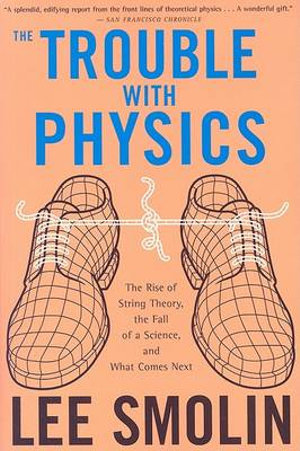 I posted about this book earlier, noting that it was surprisingly hard to get into, particularly for someone such as myself who, while not majoring in physics in high school, has always been curious about science and particularly interested (since a young age) in the concepts surrounding quantum physics. Boy, what a difference the last half of a book can make.
I posted about this book earlier, noting that it was surprisingly hard to get into, particularly for someone such as myself who, while not majoring in physics in high school, has always been curious about science and particularly interested (since a young age) in the concepts surrounding quantum physics. Boy, what a difference the last half of a book can make.
Smolin’s approach to the organization of information in his book might make sense to him, and – if I had an undergraduate in physics – it would to me also. He begins by stating five fundamental unsolved problems with our understanding of the universe, not already explained by Einstein’s theory of relativity (governing big stuff) and quantum physics (governing small stuff). He then goes on to discuss the idea of string theory and how it was posited as a candidate for a unifying theory which might possibly go to explain these unresolved problems (along with the effects of gravity). After laying out the details, he then discusses the chronology of string theory’s rise, its propagandists and critics. It’s in Smolin’s detailed breakdown of each subsequent argument from the string theory camp that makes The Trouble With Physics: The Rise of String Theory, the Fall of a Science, and What Comes Next such a slog; I get it, he wants to be fair to those theorists and also be careful to place said theories within theoretical and historical context — and yet he does not create the space to be able to explain these theories for a wider audience (in my defence, in case you feel this is unrealistic an expectation, one of the critic blurbs on the book raves about how Smolin’s book clarifies the string theory debate for “the layman”. My assumption is that “layman” stops at a high school education, and some would even call that generous if you account for how much we forget if we do not further our study in that field). There are many pages in which I freely admit to reading the first sentence of each paragraph so that I could at least know where I was in the chronology of the given argument, and the rest was often arcane.
I feel that if Smolin had structured his book so that the first half wasn’t so front-loaded with technical conjecture, there might be more patience for what follows. The good news is that at some point Smolin realized he needed to describe his problems with string theory from the perspective of a systemic problem within his own field of study. That is to say, he begins to switch to a more opinionated and personal/anecdotal perspective. As I mentioned in my lead-up, I was able to find a number of non-literal ways to frame his argument beyond the scope of his book, which made my desire to keep reading more rewarding when I reached the last half. What happens when the majority of your peers are passionate about something you have fundamental problems with, problems you feel — if overly invested in — will set your area of interest back decades? It’s a case Smolin makes early and often; namely, that string theory — fashionable and sexy — has become ubiquitous on elite campuses and yet cannot be proven through basic experimentation; that, in order for it to explain anything, it would need a constantly changing set of factors to back it up at any given moment. It’s beautiful and ornate, which makes it dangerously alluring, and yet it cannot actually predict anything useful, and it has been this way for over 20 years, which Smolin impresses upon us is an unheard of amount of time in the modern history of science for a theory to survive between positing and non-confirmation, without being discarded.
As much as I feel that it’s unfair to expect something as abstract as quantum physics to be easily translatable to the general public, there is a part of me that stubbornly believes that we must always strive to present the most important ideas of our day into the domain of the everyman. Does this book that? Not well, but that alone is no reason to bypass it. It was controversial in its time, and I’m curious to see if Smolin has any interest in following up.
The Trouble With Physics: The Rise of String Theory, the Fall of a Science, and What Comes Next, by Lee Smolin (ISBN 978-0618918683) is available through an independent bookstore near you.

